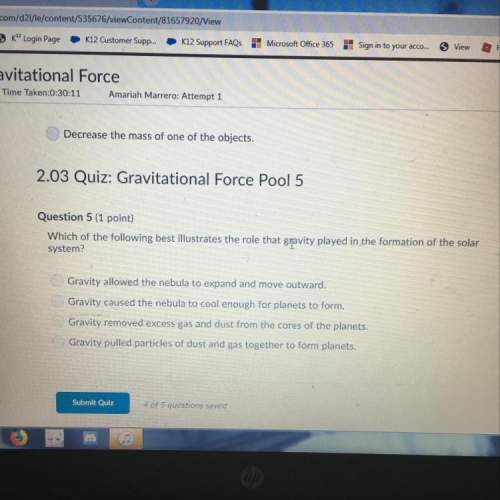Experiment: using the tyndall effect to identify colloids
these supplies are needed:
3...

Chemistry, 16.09.2019 21:50 lanashanabJHsbd1099
Experiment: using the tyndall effect to identify colloids
these supplies are needed:
3 clear glasses with smooth sides
laser pointer or flashlight
red jell-o®
red food coloring
sugar
water
procedure:
using the regular recipe, mix up the jell-o® and fill one glass with the mixture. let the jell-o® chill until it gels. fill another glass with water and let it settle until the air bubbles disperse. fill the third glass with water and add 2 drops of food coloring and two tablespoons of sugar. stir until you are sure the sugar is completely dissolved.
when all three glasses are ready, line them up in any order and shine the laser (or flashlight) through all three glasses at the same time.
answer these questions:
what did you observe?
what is the tyndall effect?
which glass displayed the tyndall effect?
what does that tell you about the substance in the glass?
which glass represents a pure substance?
which glass represents a solution?

Answers: 1


Another question on Chemistry

Chemistry, 22.06.2019 07:20
Describing intermolecular forces use the drop down menus to match the type of intermolecular force to its name dipole dipole interactions dipole induced dipole interactions london dispersion forces hydrogen bond van der waals forces done
Answers: 1

Chemistry, 22.06.2019 09:00
Scientific evidence tells us that the cause of earths four season is the tilt of earth as it revolves around the sun. the student is instructed to illustrate this information in a science notebook. how will the student illiterate winter in the northern hemisphere?
Answers: 3

Chemistry, 22.06.2019 10:30
Great amounts of electromagnetic energy from our sun and other bodies in space travel through space. which is a logical conclusion about these electromagnetic waves? their energy must be very their frequency must be very low these waves can travel without a medium they only travel through a vacuum of space
Answers: 2

Chemistry, 22.06.2019 13:30
What does the xylem do? stores the glucose captures the sunlight absorbs oxygen into the leaf carries water from the roots to the leaves
Answers: 1
You know the right answer?
Questions

Chemistry, 02.11.2019 16:31

Spanish, 02.11.2019 16:31

Mathematics, 02.11.2019 16:31

English, 02.11.2019 16:31

Computers and Technology, 02.11.2019 16:31

Chemistry, 02.11.2019 16:31

Arts, 02.11.2019 16:31


Social Studies, 02.11.2019 16:31

Mathematics, 02.11.2019 16:31


Mathematics, 02.11.2019 16:31

Physics, 02.11.2019 16:31



Mathematics, 02.11.2019 16:31

Mathematics, 02.11.2019 16:31

History, 02.11.2019 16:31





